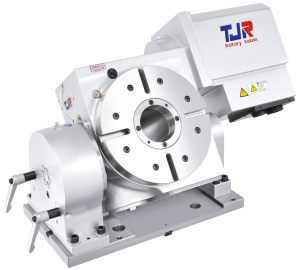
Most rotary tables are mounted flat, operating around a vertical axis. Another setup involves mounting the tool on its end, or mounting it on a 90-degree angle plate to allow it to rotate on a horizontal axis, allowing the workpiece to be held between centers. The benefits of extra precision and flexibility are the main reasons why the use of a 90-degree tilting base is the de facto standard in high-precision modeling industry.
A tilting rotary table is good for cutting a spherical piece with a protruding tang, creating intricate shapes and curves, and cutting solid objects at difficult angles.
Choosing the Right Tilting Rotary Table
Modeling metal objects demands a high level of engraving, cutting and carving, so the design requirements of the end products should be carefully assessed when choosing a rotary table.
Among the important features and characteristics to consider are the angles of table rotation, hand wheel ratio, scale resolution and size. Accuracy, efficiency and design are interrelated, thus the technical specifications of a rotary table should be thoroughly assessed and compared to those of other brands.
For instance, the accuracy of worm and wheel set tends to exceed the estimates of most European manufacturers when the table diameter is more than 500 mm. A larger gear set means greater surface contact, and higher accuracy can be maintained prolonged depending on the strength of mechanical gearing.
More On Tilting Rotary Tables
The effectiveness of a tilting rotary table depends on how operators feel toward the tool. The design of the rotary table can be good or bad relative to the experience of a cutter.
A tilting rotary table can be used on various materials other than metals. In a high-volume industrial setting, rotary tables’ multifunctional features are taken into account. Features like variable speed control should be assessed carefully to determine if a rotary table is suitable for a certain task. Another concern is capacity and lifespan. The capacity of a rotary tool is harder to confirm or guarantee. High-volume metalwork requires a very durable rotary table that can remain in good shape and withstand extended use.
One of the key advantages of buying a rotary cutting tool from established manufacturers such as CNC Indexing & Feeding Technologies is the low cost of maintenance. Depreciation cost is a huge factor when selecting metalwork equipment, so paying a premium for quality and durability is the best option for any business. With CNC Indexing, getting replacement parts or repair services for your rotary table can be a simple process with our in-house resources and applications expertise.
CNC Indexing offers standard, compact and manual tilt rotary tables from TJR Precision Technology:
- Standard: The FAR Series is a standard pneumatic brake tilt rotary table line available in single arm, cradle type dual arm, and extended cradle type dual arm options. The FHR Series standard hydraulic brake line is available in dual arm cradle type and dual arm extended cradle type.
- Compact: The compact tilt rotary table is available with a 170mm face plate diameter, ideal for smaller machining centers and workpieces.
- Manual: The manual tilt table has a full 4th axis (rotating axis) and a manual tilting axis and is available in 255mm table diameter. The manual tilting rotary table is ideal for customers who only occasionally require tilting axis capabilities.
Call CNC Indexing & Feeding Technologies today at 513-770-4200 to learn more about the TJR Precision Technology tilting rotary tables.


